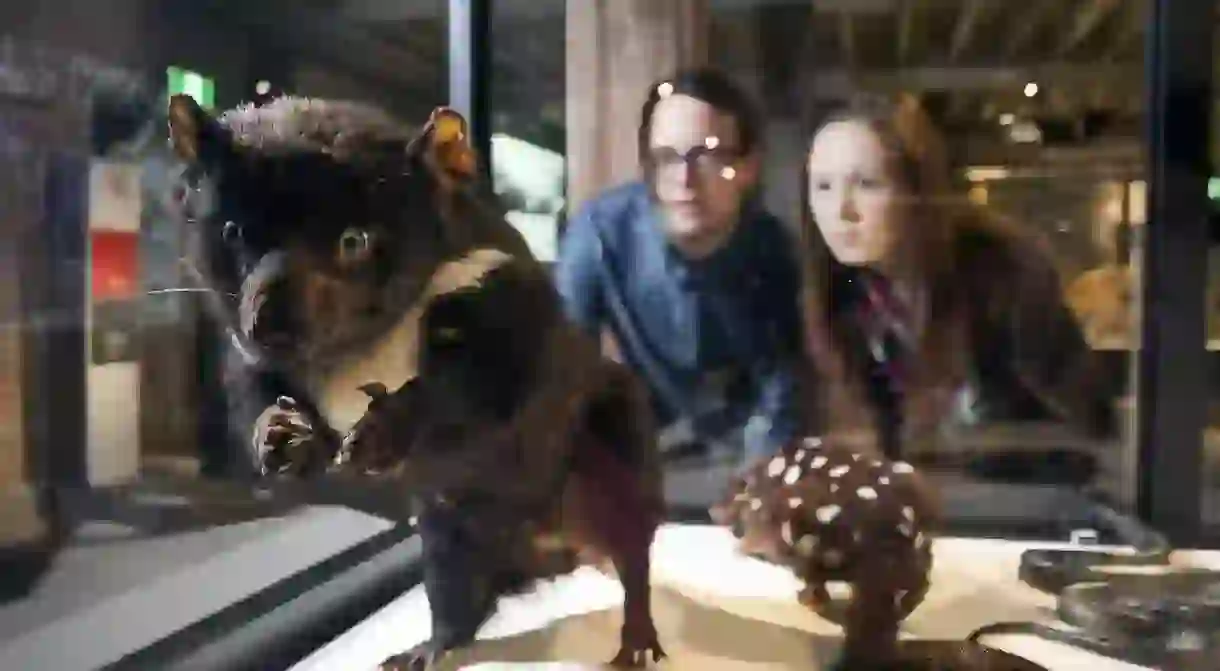The 6 Best Exhibits To Discover at the Tasmanian Museum and Art Gallery

Established in 1846, the Tasmanian Museum and Art Gallery in Hobart is Tasmania’s leading natural, cultural and heritage organisation. Here are six of the most impressive exhibits to search out on your visit.
The Tasmanian Museum and Art Gallery, located in Hobart and fondly known as TMAG to its locals, is home to a sizeable collection of art, science and history artefacts. It is the second-oldest museum in Australia, and the perfect place to spend an afternoon leisurely browsing the exhibitions on offer. Here are six highlights.
The Thylacine

There are several pieces of interest in the gallery, but an especially intriguing one is the taxidermy adult male thylacine, a now-extinct carnivorous marsupial that was also known as the Tasmanian tiger because of its striped appearance.
Hunted and killed by humans, the thylacine is an important reminder of how animals need to be protected from becoming endangered or extinct. This taxidermy thylacine looms tall in his box in a darkly lit room, inviting you to consider the terrible treatment of this species and what ultimately led to its extinction. A thought-provoking and saddening piece to stand in front of.
Tasmanian Aboriginal culture – Kanaplila dance

The Ningina Tunapri exhibition on Tasmanian Aboriginal culture displays shell necklaces, kelp water carriers and examples of basket weaving, all representing different elements of Aboriginal life. One significant section of this exhibition is dedicated to the kanaplila dance used within the Aboriginal culture to express emotions or tell stories. Clap sticks and a contemporary dance costume are both on display here and offer us an insight into Tasmanian Aboriginal culture and how it is passed down through generations.
The traditional stories and culture of the community need to be preserved and treasured. If you are interested in Aboriginal history, another important exhibit to see is Our Land: Parrawa, Parrawa! Go Away!, which tells the story of Aboriginal people and colonists after lutruwita (Tasmania) was invaded.
The Tasmanian Commemorative Medals

The Medals and Money Gallery holds a marvellous collection of more than 350 medals and coins. There are many pieces to look at in this exhibition, but the collection of Tasmanian Commemorative Medals has a local significance. Within this exhibit is the Cessation of Transportation Medal (1855), the Centenary Hobart Regatta Medal (1938) and the Hobart Sesquicentenary Medal (1954), all of which sit proudly next to historical images of people and events from when they were awarded.
Each medal tells the story of local commemorative events and their place in history, illustrating the importance of artefacts for connecting us with the past.
Ice core from Antarctica

The Islands to Ice: Antarctic Gallery is one of the most popular exhibitions at the Tasmanian Museum and Art Gallery. It is home to an ice core sample from Antarctica that dates back 300 years. This is an important piece of history as the air bubbles inside have trapped gases that have allowed scientists to observe the changes in CO2 levels.
Understanding Antarctica has always been important in Tasmania; indeed the state has a specific institute dedicated to marine and Antarctic studies. By studying ice cores from Antarctica, scientists can learn an incredible amount about the changes in the environment over the years and see the effects of climate change.
The Tasmanian Devil

Sitting in its box in one of the Bond Store galleries, a taxidermy Tasmanian Devil looks very menacing. The devil’s mouth is wide open, its pointy teeth are on full display, and the sharp claws look ready to attack. Though the devil may look small in person, these creatures are known for being feisty.
The Tasmanian Devil is a carnivorous marsupial and an endangered animal. The devils are largely threatened by the Devil Facial Tumour Disease that has wiped out much of the species over the years. The Tasmanian Devil, just like the thylacine, is a powerful reminder of how we must look after our wildlife.
‘View of Hobart Town with Mount Wellington in the Background’
The View of Hobart Town with Mount Wellington in the Background, located in the Henry Hunter Galleries, is an oil on canvas work by colonial artist Eugene von Guerard (1856). The painting depicts Hobart’s beautiful landscape with kunanyi (Mount Wellington) in the background. It is an eye-catching piece that plays with contrasting warm and cool colours and features incredible detail.
This painting shows the changes between Hobart in the 1850s and the Hobart that we now know. It is amazing to reflect on how the landscape once looked, through the eyes of an artist. It is also one of only a small number of paintings that depict this part of Tasmania by the artist.
This article is by no means an exhaustive list of the items or artwork on display at the Tasmanian Museum and Art Gallery. If you are planning on visiting the museum, make sure you check the website and see what temporary exhibitions are also available.













